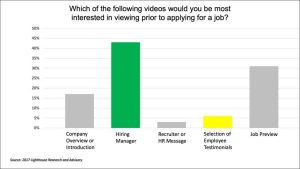When you think about a recruiting video, do you imagine a two-minute video introduction that sits on your career site? Or do you think about employee testimonials that are part of your company page on The Muse?
If you thought of either of those, you’re dating yourself.
It’s not that videos aren’t important recruitment marketing tools. They are. It’s that you may be thinking about them in the wrong way. The whole notion of a recruiting video has changed. Those high-budget, corporately produced videos that you might be thinking of? They’re no longer effective.
The Invisibility Problem
A study of 5,000 corporate career sites by CareerBuilder revealed that only 1.5% of visitors ever watched the videos on those sites.

Maybe they’re not visible enough. Maybe because people aren’t going to careers sites to watch videos. Regardless, look at the number of visitors to your own site; then look at the number of plays and finishes for your video. (Wherever your videos are hosted should have that data.) What percent of visitors watch your videos?
If that number isn’t discouraging enough, divide the cost of video production by the number of plays. It’s like sending a $300 check to each person who clicks on the “play” button. Not what anyone would call a great ROI.
The Relevance Problem
It is commonly believed that employee testimonials are the most effective content. Indeed, a survey by Ekaterina Galieva, a recent Duke University business school graduate, showed that 90% of TA respondents said that videos that have the greatest impact are employee testimonials.

If only candidates felt that way. A study by Lighthouse Research and Advisory showed that candidates were not as interested in employee testimonials as they were in a hiring manager message. This is perhaps because job-seekers are not that interested in hearing from a random employee who works in a division, function, or location different that of the job they are considering.

Reimagining Recruiting Videos
So should you give up on videos?
Not at all, just rethink how you use them. Rather than consider them as strictly recruiting tools, consider them as a form of enriched communication — sort of like email with pictures and sound.
Innovative companies encourage informal videos, often recorded on a phone or webcam, that contain information that is relevant to a specific recipient. In other words, they are sidelining high production values in favor of timely and tailored content.
Galieva’s research also indicates the many ways that organizations are increasingly using videos:
- Hiring manager introductions to applicants
- Intern documentaries of internship experiences
- Leaders showcasing departments
- Introductions to virtual hiring events
- Discussion of candidate FAQs
- Hiring manager discussions of qualities desired in a candidate
- Individualized 30-second pitches to passive candidates
- “Meet our Team” introductions
- Virtual tours of offices
- Explanations of interview process
- Highlights of a safe culture and commitment to employee safety
- Intros and outros to video interviews
- Day-in-the life of a product to showcase distribution centers
- Instructions and help sections as part of the application process to improve accuracy
- Teams welcoming new employees
- Onboarding instructions
- Welcome messages to new employees, birthday wishes, thank-you videos
- Depictions of stages of the compliance and background check
- Immediate supervisor and team welcome sent with offer letter
Producing videos to meet these specific needs requires not only a different approach to video but a different process. Obviously, if every new employee is sent welcome videos from team members, the volume of videos will exceed the capacity of legal, compliance, marketing and corporate communications to review and approve each of them. You’d need a video management system and guidelines to ensure consistent messaging and brand appropriateness.
If that sounds overwhelming or like something that will never happen at your company, think again. It’s already happening at your competitors’. Never mind that more and more candidates are expecting video as part of the process.
We talk a lot about humanizing recruiting, only to continue to put candidates through the usual impersonal process. But with the right use of video, you can finally fulfill the promise of humanizing recruitment.
